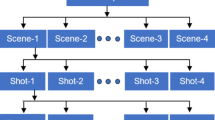Abstract
This chapter presents a novel cellular neural network architecture for image binarization in video sequence. The cellular network is part of a neuro-inspired system used to detect dynamic objects in video sequences. Among its novelty is that besides binarization it is able to reduce also noise, and its parameters are self-adapted. Qualitative findings are used to show the advantage of using the cellular network.
Access this chapter
Tax calculation will be finalised at checkout
Purchases are for personal use only
Similar content being viewed by others
References
Yu, B., Zhang, L.: Pulse-coupled neural networks for contour and motion matching. IEEE Trans. Neural Netw. 15(5), 1186–1201 (2004)
Faro, A., Giordano, D., Spampinato, C.: Evaluation of the traffic parameters in a metropolitan area by fusing visual perceptions and CNN processing of webcam images. IEEE Trans. Neural Netw. 19(6), 1108–1129 (2008)
Costantini, G., Casali, D., Carota, M., Perfetti, R.: A CNN-based algorithm for moving object detection in stereovision applications. In: Proceedings of International Conference on Circuit Theory and Design European, pp. 500–503, Aug 2007
Wei-Song, L., An-Te, L., Chun-Hsiung, F.: Computational autonomous visual perception using cellular neural networks. In: Proceedings of IEEE International Conference on Computational Intelligence for Measurement Systems and Applications, pp. 198–202, July 2005
Dubravko, C., Marques, O., Socek, D.: Neural network approach to background modeling for video object segmentation. IEEE Trans. Neural Netw. 18(6), 1614–1627 (2007)
Maddalena, L., Petrosino, A.: A self-organization approach to background subtraction for visual surveillance applications. IEEE Trans. Image Process. 17(7), 1168–1177 (2008)
Chacon-Murguia, M.I., Gonzalez-Duarte, S., Vega-Pineda, J.: Simplified SOM-neural model for video segmentation of moving objects. In: Proceedings of International Joint Conference on Neural Networks, pp. 14–19, June 2009
Chacon-Murguia, M.I., Gonzalez-Duarte, S.: An adaptive neural-fuzzy approach for object detection in dynamic backgrounds for surveillance systems. IEEE Trans. Ind. Electron. 59(8), 3286–3298 (2012)
Ghasemi, A., Safabakhsh, R.: Unsupervised foreground-background segmentation using growing self organizing map in noisy backgrounds. In: Proceedings of 3rd International Conference on Computer Research and Development, pp. 334–338, Mar 2011
Baier, V.: Motion perception with recurrent self-organizing maps based models. In: Proceedings of International Joint Conference on Neural Networks, pp. 1182–1186, July 2005
Avila-Mora, I.M., Castellanos-Sanchez, C.: Bio-inspired clustering of moving objects. In: Proceedings of Congress on Intelligent Systems, pp. 58–62, May 2009
Miikkulainen, R., Bednar, J.A., Choe, Y., Sirosh, J.: Computational Maps in the Visual Cortex. Springer Sciences Media Inc., Ed., New York (2005)
Brutzer, S., Höferlin, B., Heidemann, G.: Evaluation of background subtraction techniques for video surveillance. In: Proceedings of Conference on Computer Vision and Pattern recognition, pp. 1937–1944, June 2011
Chua, L., Roska, T.: Cellular Neural Networks and Visual Computing Foundation and Applications. Cambridge University Press, New York (2004)
Acknowledgments
The authors thank the Fondo Mixto de Fomento a la Investigación Cientifica y Tecnologica CONACYT-Gobierno del Estado de Chihuahua under grant CHIH-2012-C03-193760 and Tecnologico Nacional de Mexico under grants CHI-MCIET-2013-230 and CHI-IET-2012-105.
Author information
Authors and Affiliations
Corresponding author
Editor information
Editors and Affiliations
Rights and permissions
Copyright information
© 2015 Springer International Publishing Switzerland
About this chapter
Cite this chapter
Chacon-Murguia, M.I., Ramirez-Quintana, J.A. (2015). Cellular Neural Network Scheme for Image Binarization in Video Sequence Analysis. In: Melin, P., Castillo, O., Kacprzyk, J. (eds) Design of Intelligent Systems Based on Fuzzy Logic, Neural Networks and Nature-Inspired Optimization. Studies in Computational Intelligence, vol 601. Springer, Cham. https://doi.org/10.1007/978-3-319-17747-2_8
Download citation
DOI: https://doi.org/10.1007/978-3-319-17747-2_8
Published:
Publisher Name: Springer, Cham
Print ISBN: 978-3-319-17746-5
Online ISBN: 978-3-319-17747-2
eBook Packages: EngineeringEngineering (R0)




